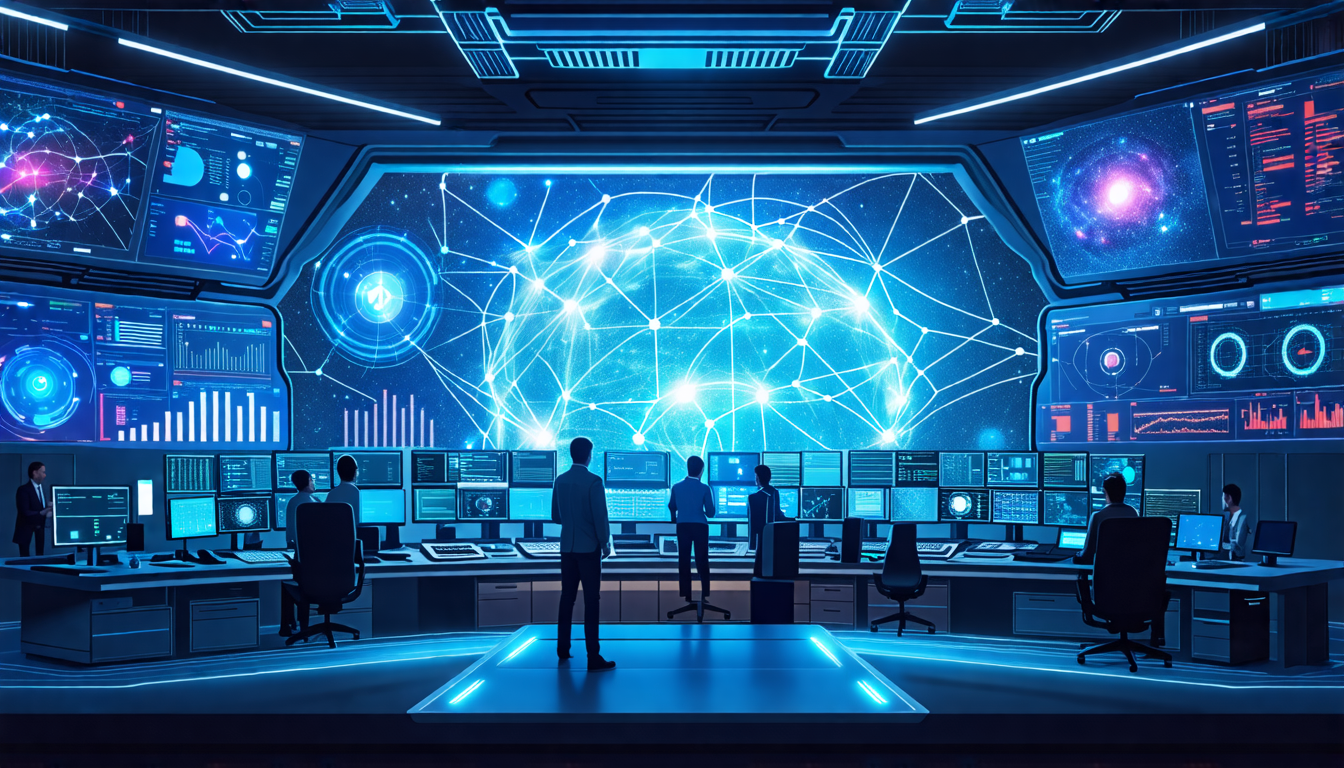
Enhancing AI Safety Systems: Ensuring a Secure Future
In an era where artificial intelligence (AI) is rapidly becoming the driving force behind transformative changes across industries, ensuring its safe deployment is crucial. Enter AI safety systems—the unsung heroes of the tech world, dedicated to securing a future where innovation and safety go hand in hand. These systems, far from being mere add-ons, are pivotal in the development and implementation of AI technologies. They serve as the guardians of humanity’s future, mitigating the risks inherent in unchecked AI advancements.
As we increasingly entrust AI with responsibilities in healthcare, finance, transportation, and beyond, the imperative for robust safety measures mounts. However, the path to effective AI safety is laden with challenges. Designing comprehensive systems requires navigating a labyrinth of ethical considerations and regulatory frameworks, while also staying one step ahead of potential risks, as starkly highlighted by recent industry mishaps.
Progress is fueled by innovative strategies and collaborative initiatives among tech companies, policymakers, and academia, all striving to bolster the reliability of AI safety systems. Cutting-edge research continues to unveil solutions to existing vulnerabilities, ensuring these systems can withstand ever-evolving threats.
Looking ahead, AI safety systems are poised to shape the landscape of technology deployment, fostering an environment of trust and ethical integrity. It is imperative that we remain steadfast in our commitment to advancing these systems, for they are the cornerstone of a secure and prosperous AI-powered future. Let us champion this endeavor, recognizing that the investment in AI safety today is an investment in the safety and success of tomorrow.
1. Introduction to AI Safety Systems
Artificial Intelligence (AI) may seem like something out of a science fiction novel, but its presence and impact are increasingly becoming a reality. As such, the significance of AI safety systems has never been more pronounced. But what exactly are these systems, and why are they indispensable?
To put it simply, AI safety systems are sets of protocols, algorithms, and structures designed to ensure that AI technologies operate within safe and ethical boundaries. Much like how airbags are to cars, safety systems are crucial for AI. Their primary role is to mitigate risks associated with AI technologies, ensuring that these powerful tools do not run amok, either intentionally or due to oversight.
The importance of implementing robust AI safety systems cannot be overstated, especially as AI technologies become more integrated into the fabrics of society. As AI increasingly drives innovation across various sectors—healthcare, finance, transportation, and even entertainment— the safety net formed around these technologies must be equally advanced. With great power comes great responsibility, and ensuring the secure deployment of AI is the ultimate responsibility lying at the feet of developers, regulators, and users alike.
Consider the expansive and growing reliance across sectors: AI now diagnoses diseases, drives autonomous vehicles, powers financial models, and even predicts consumer behavior. This involves not merely processing vast volumes of data but also making decisions that can have profound impacts on individuals and societies at large. Hence, the importance of AI safety systems becomes crystal clear: we need them to prevent mishaps before they arise, protect against potential biases, and ensure AI behaves in predictable and intended ways.
Moreover, we must be attuned to the implications of AI technology that, while revolutionary, may inadvertently introduce new risks. History has shown us the technological bungles that have come from unchecked innovations. Therefore, advancing AI safety systems stands as our collective insurance policy towards securing a future where AI’s benefits are reaped without succumbing to unforeseen perils.
In essence, a robust discussion around AI safety systems isn’t just about wielding control over AI. Instead, it’s about safeguarding humanity’s future. The very essence of advancement in technology must be anchored with safety and responsibility at its core. Emphasizing robust safety mechanisms, therefore, is not only prudent but essential if we are to coexist harmoniously with this unstoppable force that is artificial intelligence.
Transform Your Safety Management with AI-Powered Tools

2. Current Challenges in Implementing AI Safety Systems
As the realm of artificial intelligence continues its meteoric rise, the critical importance of AI safety systems becomes increasingly apparent. However, crafting and deploying these systems is not without its hurdles. One prominent challenge lies in the inherent complexity of AI safety systems, which must be meticulously designed to ensure they operate as intended across diverse scenarios. This complexity is compounded by the rapidly evolving nature of AI technologies, leaving safety measures perpetually one step behind the cutting-edge innovations they aim to safeguard.
Moreover, the potential risks linked to inadequate AI safety measures are significant and multifaceted. They span ethical concerns, where misaligned AI behavior could lead to undesirable outcomes, to regulatory barriers, which often lag behind technological advancements. For instance, an AI system programmed with biased data may inadvertently perpetuate social inequalities, raising ethical alarms. Such scenarios underline the urgent necessity for robust AI safety protocols that transcend mere technical efficacy, embedding ethical considerations into their core.
The regulatory landscape further complicates the implementation of AI safety systems. Many existing frameworks are ill-equipped to handle the nuances of AI technology, either being too lenient or excessively stringent. This mismatch stifles innovation while failing to provide the necessary guardrails essential for safe AI deployment. Aligning regulatory measures with technological advancements is crucial, as misalignment can lead to a stunted deployment of beneficial AI technologies or, conversely, the unchecked proliferation of potentially harmful ones.
In assessing recent case studies, we witness a palpable embodiment of these challenges. Consider the infamous incident involving an AI-driven credit scoring system that inadvertently discriminated against certain demographics due to unintentional bias in its training data. The fallout from such incidents not only damages reputations but also erodes public trust in AI technologies. These cases serve as stark reminders of the imperative need for more robust and ethically sound AI safety systems.
Further complicating the scene is the elusive nature of AI’s explainability. Many AI models, particularly those utilizing deep learning techniques, operate as opaque black boxes. This lack of transparency poses a significant challenge for AI safety systems, as it becomes incredibly difficult to predict and mitigate risks associated with their inscrutable decision-making processes. Ensuring transparency within AI systems is a daunting task, often requiring sophisticated methods to decipher the intricate web of neural networks.
Additionally, the global nature of AI deployment introduces cross-border challenges. AI safety systems that operate effectively within one regulatory framework may not comply with another’s standards. This regulatory dichotomy can lead to vulnerabilities and inefficiencies in multinational operations, calling for international collaboration in formulating universal safety standards. Such global cooperation is pivotal in harmonizing AI safety systems, ensuring they provide consistent protection across all jurisdictions.
Lastly, financial constraints present a formidable barrier to the widespread implementation of comprehensive AI safety systems. Developing and maintaining these systems demands substantial resources, often placing significant strain on smaller enterprises and stymying innovation in the broader AI landscape. As such, equitable access to resources and knowledge is essential to democratize the field of AI safety, enabling even the smallest startups to contribute towards building a secure AI future.
In summation, the journey towards effective AI safety systems is fraught with complex challenges. Whether it’s navigating the intricate design requirements, grappling with regulatory misalignment, addressing ethical considerations, ensuring system transparency, managing cross-border complexities, or overcoming financial hurdles, each obstacle presents an opportunity for growth and innovation. By addressing these challenges head-on, we pave the way not only for safer AI technologies but also for a future where AI systems are both a boon to humanity and a testament to our collective ingenuity.
Transform Your Safety Management with AI-Powered Tools

3. Strategies for Enhancing AI Safety Systems
Artificial intelligence continues to cast its ever-growing shadow over numerous facets of our daily lives, and while this impressive digital marvel offers immense potential, managing AI safety systems remains the linchpin for ensuring these technologies do not run amok. To bolster the efficacy of AI safety systems, innovative strategies and cutting-edge technologies are being explored with fervor.
Innovative Strategies and Technologies
In the ever-evolving ecosystem of AI, deploying a multi-layered safety net is paramount. One noteworthy strategy is the incorporation of explainable AI, a frontier pushing AI to not just make decisions, but to elucidate them. This transparency aids developers in comprehensively understanding AI behavior, thereby facilitating preemptive adjustments to avoid unforeseeable glitches.
Meanwhile, reinforcement learning is increasingly being utilized. By simulating real-world scenarios, AI models can be trained to see potential malfunctions as adverse events. The more realistic the scenario, the better AI can learn safe and ethical behavior, minimizing chances of error when deployed in the wild.
Collaborative Efforts for Advancement
Successful enhancement of AI safety systems is not a one-man show. It requires a symphony of collaboration across tech companies, governments, and academic institutions. Governments play a crucial role in setting regulatory frameworks that incentivize tech companies to prioritize safety. Similarly, academic researchers provide a wealth of unbiased scrutiny and innovation, pushing AI safety beyond traditional boundaries. Collective brainstorming and standardized safety protocols are continually being developed and refined in cross-disciplinary conferences and think tanks.
Cutting-Edge Research and Development
Diving into the depths of research and development, recent initiatives have shown promise in addressing AI safety vulnerabilities. Advanced algorithms are being designed to autonomously detect and mitigate potential biases, effectively curbing the detrimental impacts of skewed data sets. These “self-healing” systems can recognize flaws in real-time, granting a layer of resilience unseen in previous iterations.
Moreover, the advent of federated learning presents a thrust toward secure data utilization. This model allows AI systems to learn collaboratively from decentralized data sources, safeguarding sensitive information and reducing the risks associated with centralized data breaches.
DeepMind and OpenAI, alongside numerous academic institutions, have embarked on research that delves into multi-agent safety. This research explores how multiple AI systems can interact harmoniously, reducing the risk of adversarial dynamics that could compromise safety.
In conclusion, advancing AI safety systems requires a concerted effort across various innovative strategies and technologies. By fostering intricate collaboration and pioneering research and development, we edge closer to AI systems that can operate safely and ethically within our society. The endeavor to build robust AI safety systems is not just an aspiration; it is an imperative, demanding relentless dedication and foresight from all stakeholders involved.
Transform Your Safety Management with AI-Powered Tools

As the world hurtles towards an AI-dominated future, the role of AI safety systems becomes a linchpin in ensuring secure deployment across industries. Looking ahead, we anticipate a tapestry of innovation in the safety domain, weaving together sophistication and resilience to safeguard both users and the environment amidst the AI revolution.
Forecasting future trends and advancements in AI safety systems is akin to charting a course across uncharted waters, yet the compass is already beginning to take shape. We can expect exponential improvements through the integration of machine learning techniques tailored specifically for safety analytics. As these systems become more nuanced, they may leverage anticipatory mechanisms that predict potential hazards before they amass into tangible threats, thus building a formidable frontline defense.
This technological leap in AI safety systems promises to elevate public trust, which is a crucial component in the ethical deployment of AI technologies. With safety measures embedded in every level of AI deployment, from inception through operation, stakeholders can be reassured of minimized risks associated with AI interactions. Transparency mechanisms—such as clearer algorithmic decision-making processes—are expected to enhance users’ confidence in AI systems, fostering not only trust but also wider acceptance and ethical usage of AI.
Yet, technological strides alone are not sufficient. As we stand on the precipice of these innovations, it’s a stark reminder of the importance of a proactive call to action for continuous investment in AI safety research and development. This commitment involves marshaling resources towards AI frameworks that are not only robust against known threats but are also agile enough to adapt to emerging challenges. Public and private sectors must ally in a concerted effort, ensuring that AI safety remains a priority on strategic agendas.
As AI safety systems evolve, they will redefine the tech landscape, becoming the backbone of secure and prosperous futures. By prioritizing safety in AI systems, not only do we protect society from potential pitfalls, but we also unlock the profound possibilities artificial intelligence promises. Embracing a future rich with innovation demands vigilant stewardship of AI safety systems today.
In the quest to harness the veritable power of artificial intelligence while keeping potentially adverse consequences at bay, the enhancement of AI safety systems shines as an imperative cornerstone for a secure future. As we’ve navigated through the nuances of AI safety’s importance, it’s apparent that our increasing dependence on AI across myriad sectors amplifies the stakes—and the urgency—for robust safety mechanisms.
Yet, implementing these systems is not without its hurdles. From navigating intricate ethical terrains to clearing regulatory mazes, the path is fraught with challenges. Recent incidents have illustrated the tangible risks of inadequately safeguarded AI, underscoring the critical nature of this conversation. The absence of solid safety measures exposes us to ethical quandaries and potential harm that we can ill afford.
Solutions lie within a landscape of collaborative innovation, where tech giants, visionary governments, and astute academics unite to craft cutting-edge responses. Groundbreaking research is steadily unraveling vulnerabilities, setting the stage for safety systems that not only anticipate risks but deftly mitigate them.
Looking forward, the evolution of AI safety systems promises to reshape both public trust and the ethical dimensions of AI deployment. These systems stand to be the linchpins that ensure AI technology serves humanity’s greatest good, rather than its peril. Thus, investing in ongoing research and development is not just wise—it’s essential. We hold the keys to crafting a future where AI not only operates seamlessly but does so with the peace of mind that our security is unwaveringly protected. It’s time to embrace this investment with both foresight and fervor.
Related Post
Recent Posts
- Revolutionizing Water Safety Monitoring: How AI is Making Waves in Environmental Protection
- Transforming Workplace Safety: The Impact of AI-Driven Safety Culture Programs
- Revolutionizing Workplace Safety: The Role of AI in Smart PPE Technology
- Revolutionizing Workplace Safety: How AI-Driven Solutions Enhance Health and Security
- Revolutionizing Marine Safety: How AI is Transforming Safety Systems on the High Seas


